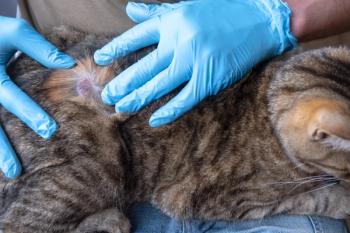
One survey, two questions, zero spread of heartworm
The American Heartworm Society (AHS) asked 40,000 animal-health professionals to respond to a two-question survey this summer that could help prevent the spread of heartworm disease to areas that, until recently, rarely had had a case, AHS President Sheldon Rubin says.
Batavia, Ill. — The American Heartworm Society (AHS) asked 40,000 animal-health professionals to respond to a two-question survey this summer that could help prevent the spread of heartworm disease to areas that, until recently, rarely had had a case, AHS President Sheldon Rubin says.
"One of the biggest issues we have with heartworm disease is that it is totally preventable," Rubin says, "but as time goes on, the areas of the United States thought to have low to no incidence of heartworm are popping up with heartworm cases."
For example, veterinarians in Arizona, California and Nevada, which typically have not had heartworm cases, are now treating dogs for the disease.
"We get e-mails every day from California and Arizona veterinarians seeing heartworm cases and asking how to treat it and what to do to prevent it," Rubin says.
AHS' mission is to be the global resource for the prevention, diagnosis and treatment of heartworm disease information, and the heartworm incidence survey is a huge part of that.
The survey, made possible by corporate sponsorship, is available as hard copy from Bayer, Ft. Dodge, Merial, Novartis, Pfizer, Intervet/Schering-Plough or Virbac sales representatives. It was sent to veterinary clinics, hospitals and shelters this summer so animal professionals can record the number of dogs diagnosed and treated for heartworm disease in 2007.
Banfield, The Pet Hospital, which has 715 hospitals in 46 states, will be sharing county by county data from its individual hospitals with AHS for the survey, says Dr. Elizabeth Lund, senior director of research with Banfied.
The survey, which last recorded cases in 2004, asked just two questions: How many dogs were tested for heartworm, and how many were positive? But it is much more extensive than previous surveys in terms of who will receive it, Rubin says.
About 250,000 positive heartworm cases were reported in the last survey, which had better than a 50 percent response, Rubin says. Aiming for more responses this time, the survey went to shelters and was put on their list serve. In addition, representatives from the pharmaceutical companies who travel to veterinarians' offices will take a copy around with them. And the questions can be answered online at
Although the survey focuses only on dogs, Rubin says AHS is aware that if results show heartworm in dogs, it is certain cats have the disease, too.
Ultimately, AHS hopes to eradicate heartworm and will continue targeting pet owners and veterinarians through an enhanced multi-media Web site and its sponsored awareness campaigns. A "Heartworm University" program will extend AHS's outreach to veterinarians by targeting 10 state and local veterinary medical association programs per year. Targeted areas will include those perceived as having little heartworm risk.
Data from the 2007 survey will be posted on the AHS Web site in late 2008 or early 2009, with the incidence of heartworm broken down by county for the entire country. The survey will be conducted again in 2010 in accordance with the society's three-year plan.
Newsletter
From exam room tips to practice management insights, get trusted veterinary news delivered straight to your inbox—subscribe to dvm360.






